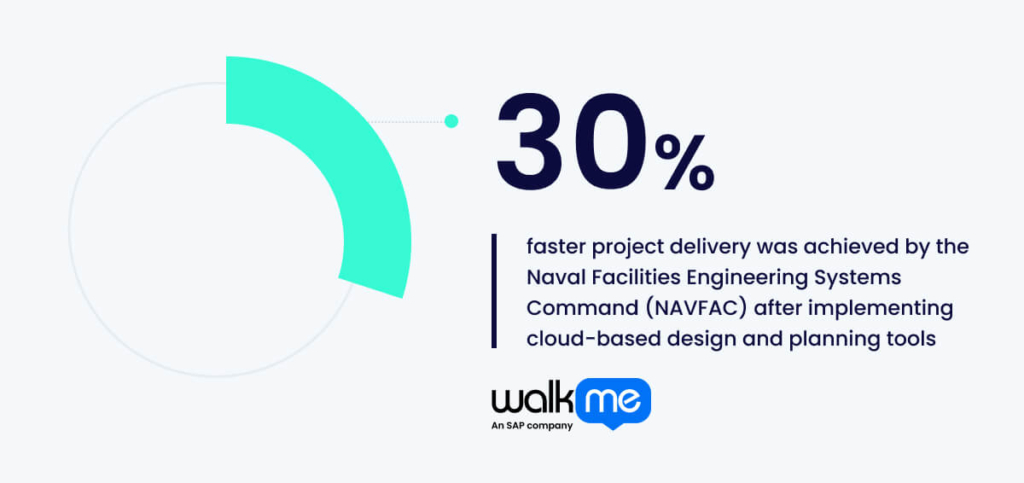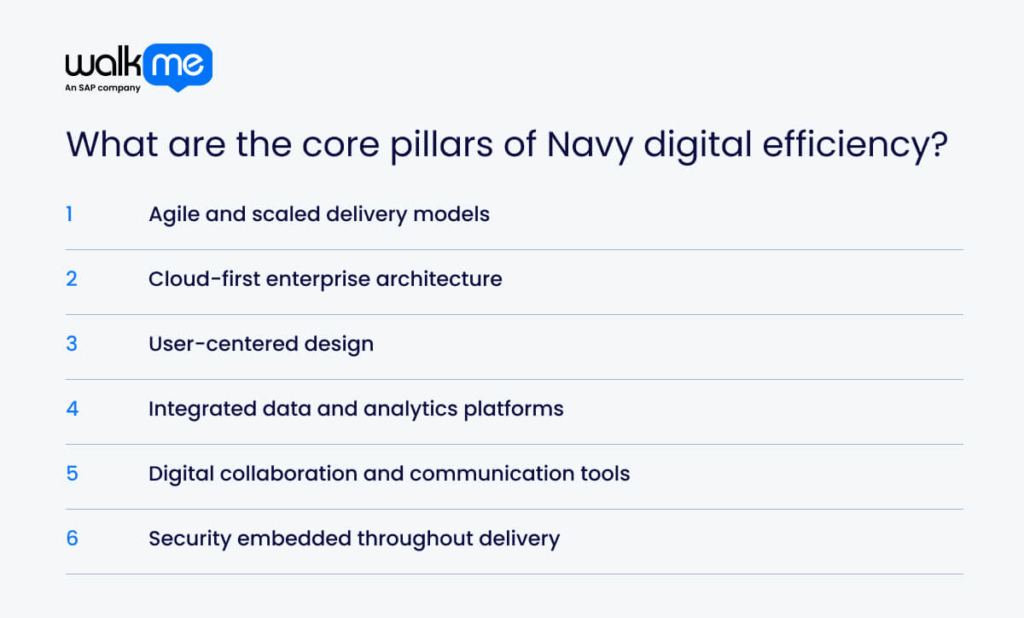As the U.S. Navy modernizes its shore infrastructure and shipbuilding operations, digital efficiency has become a driving force behind smarter digital workflows and cost optimization.

From asset performance management (APM) on submarines to digitized supply chain tracking at ports, technology is recasting its net and redefining how the Navy manages assets, coordinates logistics, and maintains readiness across its vast operational infrastructure.
These improvements help connect shipyards, contractors, and support teams, reducing delays and costly mistakes. For the Navy, digital efficiency means smarter use of resources and clearer insight into every step of a project.
This article examines how the U.S. Navy uses digital efficiency to expedite projects, build collaboration, and maintain operational readiness.
Digital efficiency in the U.S. Navy means rethinking how everyday tasks are achieved. This includes everything from dockside maintenance to fleet logistics, as well as utilizing technology to reduce friction and waste.
Take, for example, the Navy’s adoption of digital twin models for shipyard dry docks. These virtual replicas help planners visualize repairs before lifting a vessel, preventing pricey mistakes and delays.
The aim of digital efficiency is to make the Navy’s behind-the-scenes processes work more smoothly and adeptly, so ships spend less time in port and more time ready for their missions.
Digital efficiency is a catalyst that is restructuring how the Navy approaches every task, from maintenance schedules to logistics. It builds on a foundation where processes naturally evolve, empowering teams to anticipate challenges and respond with agility before issues arise.
Digital efficiency in the US Navy helps crews adapt, solve problems, and keep missions on track in a world where every decision counts.
For example, the U.S. Navy has improved its maintenance of Arleigh Burke-class destroyers by using data to predict when parts are likely to fail. This approach helps keep ships ready for action and prevents problems before they happen.
Virginia-class Navy submarines also utilize digital copies of Virginia-class submarines to monitor systems in real-time. This means that identifying issues happens quicker and encourages repairs to be made more efficiently.
These efficiency improvements reduce downtime, helping to keep Navy ships in service longer and saving a considerable amount of money.
These examples demonstrate how digital efficiency enables the Navy to leverage technology to anticipate issues, streamline maintenance, and prolong equipment longevity.
The Program Executive Office Digital and Enterprise Services (PEO Digital) leads the effort to improve digital efficiency across the U.S. Navy.
They develop and deploy software and digital tools that replace slow, manual processes. This change enables faster information flow between sailors, ships, and shore facilities.
One major focus is on logistics platforms that track equipment in real-time. This helps crews plan repairs before problems occur, lowering downtime and extending asset life.
PEO Digital also works to connect various systems, enabling Navy personnel to access accurate information at the touch of a button.
They ensure new tools are secure and work well with existing Navy technology. Smooth integration means faster technology adoption across the fleet without interrupting missions.
Overall, PEO Digital’s work enhances Navy operations, making them more efficient and responsive, which helps maintain readiness and control costs.

Understanding the core pillars of digital efficiency is key to grasping how the Navy is evolving. These foundations reveal where change is happening and why it matters across every level of naval operations.
Let’s take a closer look at the core pillars of digital efficiency in the U.S. Navy:
Agile and scaled delivery models
The Navy no longer waits years to process, test, and field new tools. With agile and scalable delivery, teams roll out updates in short bursts, adapting to needs as they emerge. It’s a shift from rigid timelines to flexible, fast-paced development—getting useful capabilities into the hands of sailors and marines quicker, and improving them as feedback comes in from the field.
Cloud-first enterprise architecture
The Navy’s Cloud Management Office has made cloud the default, not the exception. This shift allows teams to access shared services, scale up as needed, and reduce physical infrastructure costs. Applications are hosted in secure, resilient environments that adapt to the mission. This architecture enables faster experimentation, better coordination, and the ability to pivot with minimal delay.
User-centered design
Sailors and marines should not be viewed as just end-users, but should shape the tools they use. The Navy applies user-centered design to build systems that reflect the realities of service life. Through interviews, prototypes, and direct feedback, solutions evolve to fit their routines and reduce friction. This approach builds trust and ensures technology supports the job, not the other way around.
Integrated data and analytics platforms
Integrated data platforms connect maintenance logs, logistics flows, and personnel records into one view. Analysts can spot patterns and act quickly, from fleet readiness to base operations. Decisions that once took weeks are now made in hours. Linking the right data means the Navy moves with clarity and speed and doesn’t waste time chasing information across disconnected systems.
Digital collaboration and communication tools
Work that once required in-person meetings or paper memos now happens in shared digital spaces. Teams across commands can edit, coordinate, and solve problems without delay, whether onboard a ship or at a stateside base. These tools also flatten hierarchies and open up new avenues for collaboration. The result is faster decision-making, improved teamwork, and less time lost to miscommunication.
Security embedded throughout delivery
Security isn’t an afterthought and should be baked into every stage of development. Through DevSecOps practices and Commercial Solutions for Classified (CSfC), teams integrate protections from day one. Code is tested, monitored, and updated without breaking deployment flow. Instead of reacting to breaches, systems are designed to resist them. This shift builds resilience into operations, keeping systems secure without slowing digital innovation.
Now it’s time to look at why this matters. Understanding the link between digital efficiency and agility provides the foundation to see how the Navy adapts and remains mission-ready under pressure.
Let’s take a closer look at the role of digital efficiency in maintaining digital efficiency:
Accelerating decision-making
Digital efficiency gives Navy leaders faster access to actionable information. For example, Naval Sea Systems Command (NAVSEA) now uses AI-assisted dashboards to track ship system performance across active fleets.
Instead of waiting for weekly reports, commanders can act on real-time updates. This speed enables rapid adjustments to deployments, maintenance, and logistics. This means fewer delays, more efficient resource utilization, and decisions that align with the pace of complex maritime operations.
Enhancing collaboration across programs
The Navy’s Program Executive Offices (PEOs) are adopting unified digital workspaces to connect engineering, acquisition, and logistics teams. Naval Air Systems Command (NAVAIR), for instance, uses integrated planning platforms to align aircraft upgrades with supply chain schedules.
This reduces bottlenecks and eliminates the need for duplicating identical tasks. Teams across locations can now work from the same live data, leading to clearer coordination, fewer missteps, and smoother transitions from development to delivery.
Upskilling Navy personnel
Everyone knows that technology doesn’t work without people who understand it. Through programs like Digital Horizons, the Navy is training sailors and civilians in data science, automation, and systems thinking.
Sailors aboard USS John Finn have even used digital modeling tools to support diagnostics and planning. Growing digital fluency across ranks, the Navy creates a force ready to maintain and improve evolving systems, strengthening operational flexibility from ship to shore.
Leveraging commercial cloud
To remain agile, the Navy is shifting core systems to commercial cloud platforms. Naval Information Warfare Center (NIWC) recently moved logistics tracking to the cloud, improving visibility for Pacific Fleet missions.
Cloud infrastructure allows for faster updates, scalable storage, and global access. It also supports cybersecurity and disaster recovery in ways traditional systems can’t. For a service that spans oceans, cloud-enabled flexibility is now essential.
The Navy plays a major role in keeping the U.S. safe, and staying up to date with technology helps crews be ready for whatever comes their way. This means that future-ready tools and processes make a real difference in their ability to complete their missions.
Emerging technologies are expensive and require technology roadmaps and investment that spans decades.
Digital efficiency measures ensure that technology infrastructure, software, and other systems remain effective, providing the U.S. taxpayer value for their investment while keeping them safe.
This also means digital efficiency should be approached as a major part of large-scale defense and government transformation, requiring ongoing attention to make a lasting difference.
FAQs
The Navy evaluates the speed of project completion, the frequency of system breakdowns, and the amount of money saved. They utilize data from cloud ecosystems and maintenance reports to determine if new technology is more effective. This helps them make sure they are using resources wisely while keeping everything prepared and secure.
The Navy solves tool problems by ensuring that software can work together seamlessly. They use common data formats and shared systems so information moves effortlessly between teams. This enables sailors to utilize multiple tools and systems that communicate with each other.
PEO Digital moves fast but keeps systems safe by building security into every step of development. They utilize trusted cloud services and conduct regular tests to identify issues early. This way, the Navy acquires new tools without risking safety or data.

